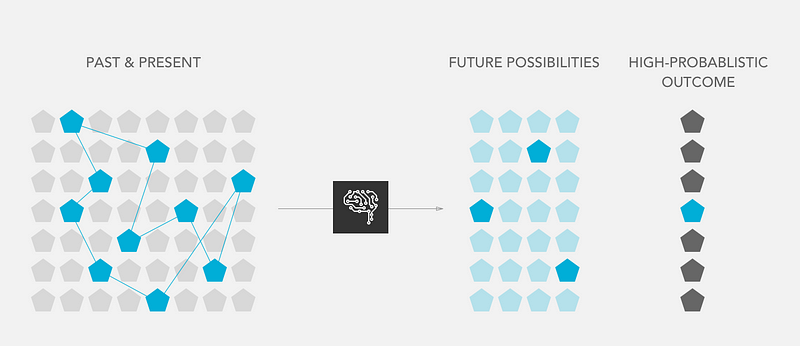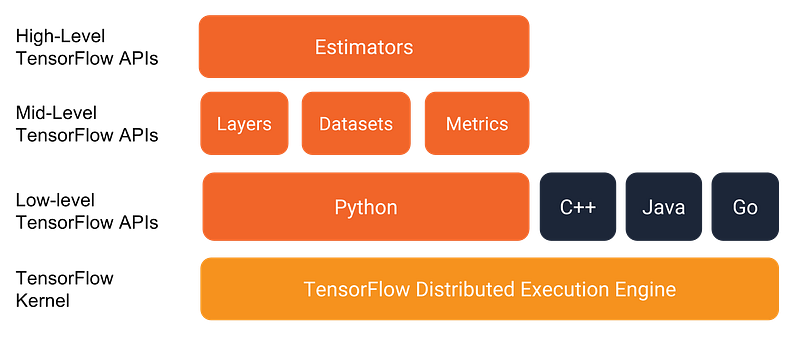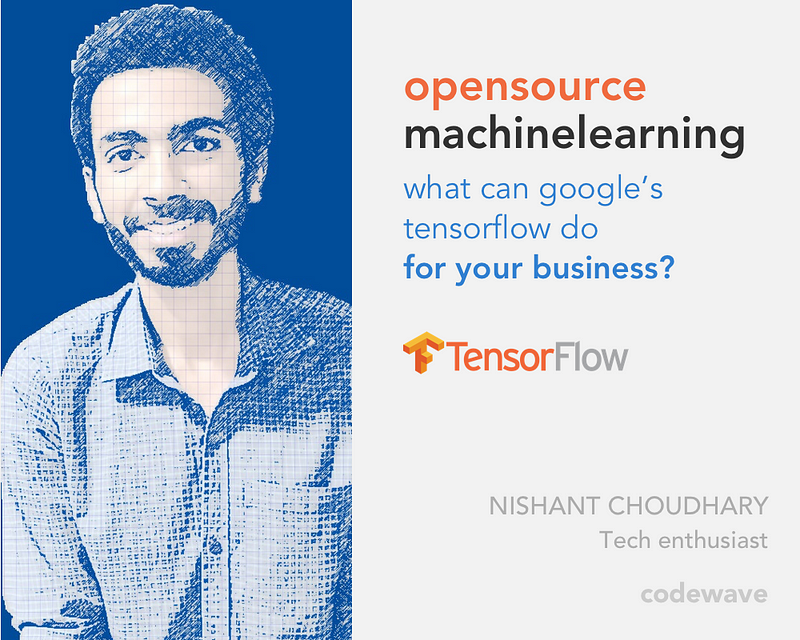What does Google’s TensorFlow mean to businesses curious about Predictive Analysis & Machine Learning?
PRIMER: Google’s TensorFlow, is an open source framework for machine learning, bringing the power of AI to every business, small and big.

AI has finally made it’s leap into startups & enterprises — the adoption is now even more accelerated with open source frameworks available for deeply integrating AI to your business. With Google announcing the release of Tensorflow 2.0, an open source framework for machine learning, the value of PetaBytes of data being produced everyday around the world has now become more significant than ever, as there’s so much more intelligence you can gain with the data today than before.
It won’t be wrong to say that year 2019 is going to witness increased penetration of AI and ML applications in enterprises and businesses especially involving predictive analysis. CTOs and IT managers are already aggressively looking out to integrate machine learning and deep learning assisted technologies into their businesses to maximize customer engagement, amplify profit opportunities, simplify operations and delivery.
Layman’s introduction to Tensorflow

Human vision can sense objects & their behavior, relationships between objects & space, send that information to the brain in realtime, which processes that information and helps interpret / make sense of the 3D world.
Computer vision mimics above, senses information (patterns of light), sends it to a digital model of the human brain that runs a machine learning program, which makes sense of the information every pixel by identifying the light patterns.
This machine learning program is programmed to recognize objects and space through information like color (wavelength of light), text / numbers / symbols (pixel patterns), and continuously self learn from data to make it’s recognition more and more accurate.
Tensorflow gives us access to powerful machine learning models that are capable of recognizing millions of real-world objects & their interactions with space. The best part is Tensorflow brings this technology to the frontend — which means realtime interpretation of the real-world can now happen from within a web browser or a mobile app interface, using the device’s audio visual receptors (like the device camera & mic).
Machine learning in its true nature is a very complex discipline but with Tensorflow Google has given the power of Artificial Intelligence and Machine Learning to just everyone. Companies of all sizes, from startups, SMEs & large corporations that are transforming the future of various industries can easily leverage the magic of machine learning and predictive analysis.
DESIGN THINKING : WHY IT MATTERS ?
A product of the Google Brain Team, Tensorflow is the most popular machine learning framework out there in the market today and guess what, it’s Open Source i.e., you may use it without spending a penny. Also, you can contribute to its development, of-course to make it better.
Ever Since its release in 2015, Tensorflow written in Python, C++ and CUDA is being excessively used for research as well as commercial applications, thanks to its crossplatform nature and unparalleled computational efficiency. When we say cross platform it means Tensorflow applications can run on any device, be it android or iOS phones, personal computer, a cluster in the cloud, CPUs, GPUs, TPUs, even from inside embedded IoT devices!
Before we talk more about how Tensorflow works and what it is used for, let’s take a sneak peek into the possibilities it unfurls for enterprises.
CODEWAVE’S DATA ANALYTICS AND MACHINE LEARNING SERVICES
Tensorflow for predictive analysis aiding realtime business applications
Predictive analytics involves scanning large amounts of data, spotting unusual patterns explaining complex, non-linear relationships from amidst huge silos of data collected in the past, put it under the what-ifs of present context and make probabilistic predictions about the future. In layman’s language, it utilizes concepts of statistics, modelling, data mining and artificial intelligence to provide insights that helps in picturing the future.

Predictive analytics applications are relevant today for every industry — be it travel & transportation, logistics & supply chain, healthcare and pharma, banking & finance, agriculture & education — assisting various business functions like marketing, customer service, operations & others. Here we list a few use cases of predictive analysis using Tensorflow.
PHARMA & HEALTHCARE
Detecting disease patterns in new patients under diagnosis: Deploying Machine Learning algorithms on medical datasets such as CLAIMS database, it is possible to find patients exhibiting similar characteristics to other patients who have been diagnosed for a particular disease in the past. For instance, using classification and regression algorithms on data of patients diagnosed for AIDS or Cancer, an ML model can be implemented to confirm if a potential patient is infected with the same.
Personalised Treatment for Patients : Using cluster analysis and scoring models (special kind of predictive modeling), it is possible to predict most efficient personalised treatment paths for individuals. Based on historical data and probabilistic outcomes, personalised drug recommendation may improve treatment success rates.
Efficient Management of Hospital Resources : Accurately predicting how many days a patient may stay under treatment can help in allocating Hospital Beds and other resources.
HEALTHCARE DIGITAL TRANSFORMATION SOLUTIONS
AGRICULTURE & FOOD INDUSTRY
Demand prediction, crop health prediction, yield prediction
We would soon be a community of 9 billion Stomachs and the demand for more and more food, quality food is inevitable. Thus, Agricultural sector needs to adopt technological advancements ASAP. We are already seeing how ML, AI and IoT in conjunction together are making it possible to detect and prevent plant diseases.
Prediction to support strategic decisions on what to sow when, for maximizing chances of a favourable outcome that can meet the demand
Predictive analysis makes it possible to predetermine quarterly and annual yield for crops by performing computations on weather and agriculture datasets. Forecasting demand and supply for crops in advance can lead to predicting future prices of dependent products. This would empower farmers to make informed decisions about what to sow and when to sow.
FARM TO TABLE : BLOCKCHAIN FOR FOOD PROVENANCE
BANKING & FINANCE
Predicting Stock Prices Using Tensorflow and Predictive analysis : It’s comparatively easier now to predict price for stocks based on analysis of past stock performance history, taking in context present day news related to that stock and analysing the sentiment associated with it alongside several other simple and complex indicators.
Detecting Fraudulent Activities : One of the applications of Predictive analysis in finance could be detecting and preventing suspicious manipulation of stock prices by discovering inappropriate patterns of buying and selling of stock shares among a group of somehow connected individuals, popularly called as circular trading.
Detecting Tax evasion: Predictive analysis bundled with pattern recognition may also address other financial frauds like tax evasion and fraudulent transactions in real time by building models based on past transactions and tax datasets.
If we keep writing, this list of potential use cases would never end because AI and ML have opened an ocean of opportunities & it’s hard to resist riding these waves esp when frameworks and libraries like Tensorflow has made it a cake walk to surf these opportunities.
If you’d like to start a conversation on the use of ML for your business, send a note to hello@codewave.in. Feel free to get in touch with us to discuss why and how you and your business should start flirting with these technologies while they are young.
BANKING & FINANCE DIGITAL TRANSFORMATION SOLUTION
Now for the techies,
How Tensorflow Works: Distributed Execution Model
Tensorflow is written using Python, C++ and CUDA. So, obviously, any Tensorflow developer must be having good grip over at least Python and C++. Although, Tensorflow does provides interface to other languages like Swift etc.
The core of Tensorflow is written using C++ & CUDA, highly optimised for performance. The Python frontend provides high level programming abstraction between different Tensorflow objects/components. The Layers API is an interface to commonly used layers in Tensorflow.
For example, tf.layers module provides high level API to construct a Neural Network.

#1: Create the model
#2: Feed input data
#3: Train the model
#4: Test the model
#5: Start Predicting
SERVERLESS ARCHITECTURE : BUILDING APPLICATIONS ON CLOUD
Tensorflow Execution Model:
Any Machine Learning application’s core functionality is repeated computation of complex mathematical expressions.
In Tensorflow, this is achieved using Data Flow Graphs. These Graphs are data structures consisting of Nodes & Tensors which fully describes the computation to be performed.
Nodes in the graph represent an instance of mathematical operations and node connecting edges are Tensors (multidimensional data array) on which computations are performed. Tensorflow expects developers to only care about application logic as it itself takes care of backend activities like algorithm implementation etc.
By adding Eager Execution, TensorBoards visualization, support for high level APIs like Keras and Estimator API, transfer learning and open sourcing many useful models Tensorflow enables rich experience for developers. It ensures flexible development environment and unparalleled computational capacities.
If this is all greek and latin, it’s perfectly alright! One of us could demystify this and help you understand what it takes to integrate the power of Tensorflow with the intelligence your business already holds.
Decisions are what makes or breaks a business. Predictive analysis empowers you with insights and accurate predictions that enables you to take informed and appropriate decisions which influences results positively.
Stay connected to Codewave for more such insights and feel free to reach us at hello@codewave.in or +91 8971824910. If comfortable you may drop by at 1st Floor, Shree Chambers, #307, Outer Ring Rd, Banashankari 3rd Stage, Bengaluru, Karnataka 560085. Thanks for taking out time to read this article. We hope it enriched your existing knowledge. Do let us know your views, by sending an email to hello@codewave.in.
Insight shared by Nishant Choudhary, Codewaver, Tech enthusiast

Tech evangelist @ Codewave.com | Writer & developer







